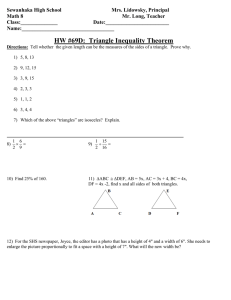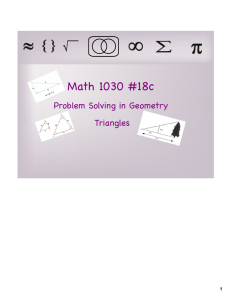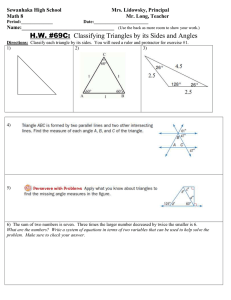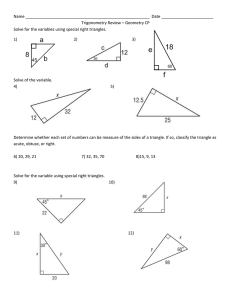Ambiguous Case
advertisement
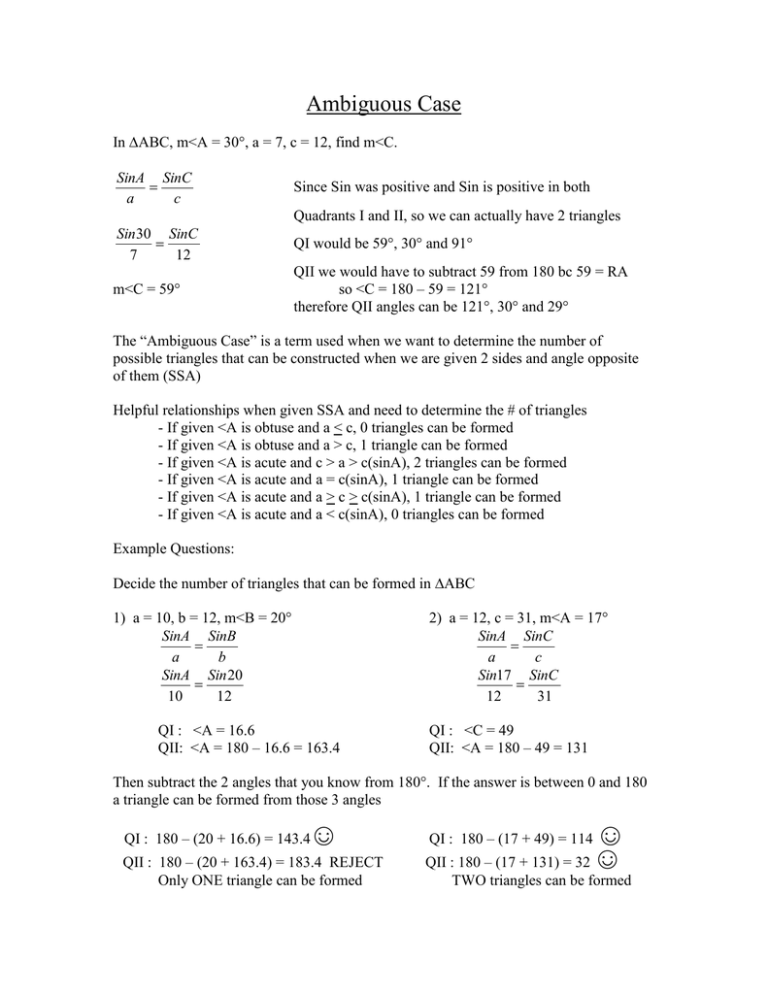
Ambiguous Case In ∆ABC, m<A = 30°, a = 7, c = 12, find m<C. SinA SinC a c Since Sin was positive and Sin is positive in both Quadrants I and II, so we can actually have 2 triangles Sin 30 SinC 7 12 QI would be 59°, 30° and 91° m<C = 59° QII we would have to subtract 59 from 180 bc 59 = RA so <C = 180 – 59 = 121° therefore QII angles can be 121°, 30° and 29° The “Ambiguous Case” is a term used when we want to determine the number of possible triangles that can be constructed when we are given 2 sides and angle opposite of them (SSA) Helpful relationships when given SSA and need to determine the # of triangles - If given <A is obtuse and a < c, 0 triangles can be formed - If given <A is obtuse and a > c, 1 triangle can be formed - If given <A is acute and c > a > c(sinA), 2 triangles can be formed - If given <A is acute and a = c(sinA), 1 triangle can be formed - If given <A is acute and a > c > c(sinA), 1 triangle can be formed - If given <A is acute and a < c(sinA), 0 triangles can be formed Example Questions: Decide the number of triangles that can be formed in ∆ABC 1) a = 10, b = 12, m<B = 20° SinA SinB a b SinA Sin 20 10 12 QI : <A = 16.6 QII: <A = 180 – 16.6 = 163.4 2) a = 12, c = 31, m<A = 17° SinA SinC a c Sin17 SinC 12 31 QI : <C = 49 QII: <A = 180 – 49 = 131 Then subtract the 2 angles that you know from 180°. If the answer is between 0 and 180 a triangle can be formed from those 3 angles QI : 180 – (20 + 16.6) = 143.4 ☺ QI : 180 – (17 + 49) = 114 ☺ ☺ QII : 180 – (20 + 163.4) = 183.4 REJECT Only ONE triangle can be formed QII : 180 – (17 + 131) = 32 TWO triangles can be formed 3) a = 4, c =12, m<A = 30° SinA SinC a c Sin 30 SinC 4 12 6 4 Reject because sin cannot Be greater than one. Sin C = NO triangles can be formed 1) 2) 3) 4) 5) 6) 7) Additional practice Answers a = 4, b = 6, m<A = 30° a = 4, b = 6, m<A = 150° a = 4, b = 6, m<B = 150° a = 15, b = 12, m<B = 45° a = 15, b = 12, m<A = 135 a = 5, b = 8, m<A = 40° a = 9, b = 12, m<A = 35° - 2 ∆’s - 0 ∆’s -1∆ - 2 ∆’s -1∆ - 0 ∆’s - 2 ∆’s 8) How many distinct triangles can be constructed if the measure of two sides are to be 35 and 70 and the measure of the angle opposite the smaller of these sides is to be 30? Ans: 0 triangles


